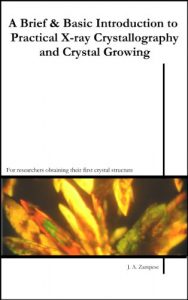For researchers obtaining their first crystal structure.
Small molecule X-ray crystallography can be divided into two separate areas - the mathematical background on how it all works, and the actual practical application of the technology as provided by a crystallography lab (for example, in an university environment). This short introductory guide concentrates on the latter. Most chemists who encounter crystallography do not necessarily need to know the physics behind diffraction, but would gain from a brief overview of the topic with emphasis on the aspects relevant to using the technique to compliment & benefit their own research.
What follows is a short summary covering the process of obtaining a crystal structure - from techniques of crystal growing to what happens after a crystal is submitted to a lab. The aim is to enlighten research chemists about:
•the difference between a good quality and poor quality dataset
•how to look at the structure of your molecule
•understand the terms asymmetric unit & unit cell
•identify basic symmetry elements and interactions
•where to start when presenting the data
An overview of a complex topic intended for postgraduate students encountering small molecule X-ray crystallography in their research for the first time – hopefully brief & light enough to digest quickly.
Contents:
Introduction
What is a crystal?
What is twinning?
Growing crystals: keep it simple
Slow evaporation
Vapour diffusion
Layering
Solubility
Persistence
What size crystals do I need?
How do I know if my crystals are good enough?
How do we see objects?
How can we see a molecule?
What is an X-ray diffractometer?
Types of diffractometers
What is a unit cell?
What is an asymmetric unit?
What is a symmetry element?
What is a space group?
Solving a crystal structure - the process
Why is my structure poor quality?
Resolution, why structures look bad
Disorder
Number analysis – what is a decent R factor?
Why isn’t my structure publishable?
What can I do if I have a bad structure?
How to open a cif file and look at your structure
Interactions
Tips for writing up or presenting a structure
Checkcif reports and CCDC deposition numbers
What can you say about a poor quality structure?
Conclusion
Small molecule X-ray crystallography can be divided into two separate areas - the mathematical background on how it all works, and the actual practical application of the technology as provided by a crystallography lab (for example, in an university environment). This short introductory guide concentrates on the latter. Most chemists who encounter crystallography do not necessarily need to know the physics behind diffraction, but would gain from a brief overview of the topic with emphasis on the aspects relevant to using the technique to compliment & benefit their own research.
What follows is a short summary covering the process of obtaining a crystal structure - from techniques of crystal growing to what happens after a crystal is submitted to a lab. The aim is to enlighten research chemists about:
•the difference between a good quality and poor quality dataset
•how to look at the structure of your molecule
•understand the terms asymmetric unit & unit cell
•identify basic symmetry elements and interactions
•where to start when presenting the data
An overview of a complex topic intended for postgraduate students encountering small molecule X-ray crystallography in their research for the first time – hopefully brief & light enough to digest quickly.
Contents:
Introduction
What is a crystal?
What is twinning?
Growing crystals: keep it simple
Slow evaporation
Vapour diffusion
Layering
Solubility
Persistence
What size crystals do I need?
How do I know if my crystals are good enough?
How do we see objects?
How can we see a molecule?
What is an X-ray diffractometer?
Types of diffractometers
What is a unit cell?
What is an asymmetric unit?
What is a symmetry element?
What is a space group?
Solving a crystal structure - the process
Why is my structure poor quality?
Resolution, why structures look bad
Disorder
Number analysis – what is a decent R factor?
Why isn’t my structure publishable?
What can I do if I have a bad structure?
How to open a cif file and look at your structure
Interactions
Tips for writing up or presenting a structure
Checkcif reports and CCDC deposition numbers
What can you say about a poor quality structure?
Conclusion






